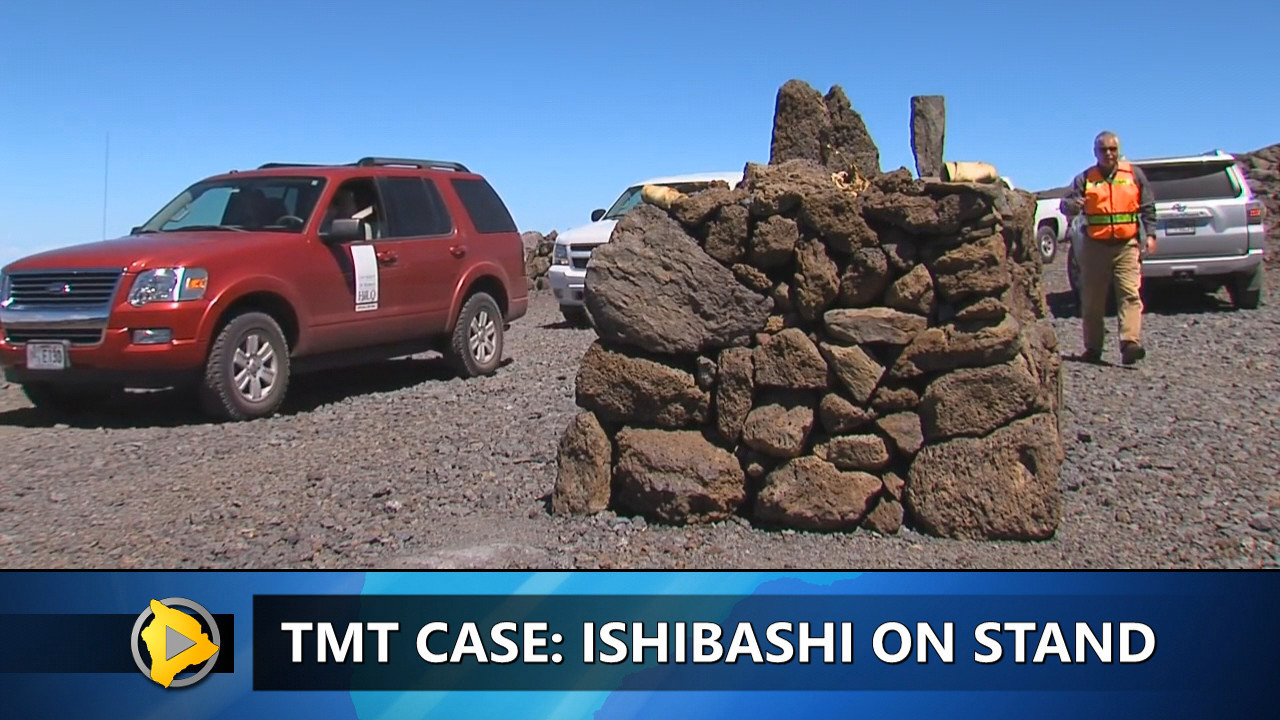HILO, Hawaii – Wally Ishibashi, the senior advisor for the Office Of Mauna Kea Management, took the stand this past week as a witness for the University of Hawaii-Hilo during the contested case hearing of the Thirty Meter Telescope.
Before he underwent an exhaustive cross-examination from TMT opponents, Ishibashi read parts of his written testimony into the record. His testimony was submitted as evidence for the university, which is seeking a conservation district use permit that will allow the $1.4 billion dollar observatory to be built on Mauna Kea.
Ishibashi made special mention of the ahu built on the mountain in 2015, saying he was deeply offended by the building of the stone altars. “The use of Kupuna Iwi as a political ploy to halt construction is one of the highest form of disrespect to our kupuna and culture,” Ishibashi declared. “HEWA.”

The ahu built on the planned site of the Thirty Meter Telescope.
Aloha, I am Wallace A. Ishibashi, Jr.
I am a native Hawaiian born and raised in Keaukaha, Hawai‘i. I learned about my culture and customs in the traditional way, from my grandparents and other members of our family. Our family roots are in Waipi‘o Valley in Hamakua. Beyond that my mother’s side of the family is from Miloli‘i, a small fishing village in South Kona, where they still practice traditional fishing.
I am also a cultural practitioner from the lineage of Poli‘ahu, so Maunakea is a very special place for me and our family. As descendants of Poli‘ahu, our family would visit our aumakua every year. I visit our ancestral guardian, our aumakua, on Maunakea whenever I can, so access to the mountain is an important part of my cultural practice.
The construction of telescopes on Maunakea has not diminished my ability to practice my culture, to worship, or to pay my respects to our ancestral spirit. In fact, the telescopes have made it easier to continue our cultural practices at the summit area of Maunakea. Before the construction of the summit road, our grandparents and their grandparents had to walk or ride horses to get to the summit. But now, because of the telescopes, they maintain the road so that we can drive to the top. They even keep it open in the winter after their snow plows clear the roadway. In all my years of visiting Maunakea, no one has interfered with or disrespected my cultural practices. However, I do feel that one’s right to practice one’s culture needs to be balanced with other things, such as safety on Maunakea – for example when the Maunakea access road needs to be temporarily closed because of snow.
As a young boy fishing at Miloli‘i with my grandfather in his canoe, I learned the old ways and was taught by my grandfather and father to respect knowledge. Later, when the voyaging canoe Hokule ‘a left for the South Pacific from Miloli‘i my hunger for knowledge grew. Prior to their trip, Papa Mau (Piailug) and Nainoa Thompson started teaching us about the stars and the moon, currents, and how important the study of the heavens was to the ancient Hawaiians. It is this quest for knowledge that is the main reason I support the TMT – because it will help my grandchildren learn more about ourselves, our God, and what’s out there beyond the stars that we can see with only our eyes.
The telescopes on Maunakea represent mankind’s most advanced search for knowledge and understanding, as learning has been and will continue to be an important part of our cultural practices. In a way, the TMT project is like a search for the aumakua or ancestral origins of the universe. How is this any different from us as native Hawaiians searching for own roots in things both natural and spiritual?
I mean no disrespect for anyone’s religious beliefs and cultural practices, but everybody has their own way of worshiping, and everyone is free to have and practice their own religious beliefs so long as they don’t hurt anyone. Not all knowledge is contained in any one halau. I am deeply offended based on the current activities surrounding the 2 newly created ahu in 2015. The use of Kupuna Iwi as a political ploy to halt construction is one of the highest form of disrespect to our kupuna and culture. HEWA. Also, I don’t agree that we should oppose things like the TMT on Maunakea just because it’s a modern thing, as Hawaiians have always been a creative and adaptive people.
In Waipi‘o, we use modern equipment like tillers and backhoes to grow taro, but we still consider this to be traditional and cultural as it allows us to survive and follow the ways and lifestyles of our ancestors. And in Miloli‘i where they still use canoes to fish the opelu, the akule and the ahi, we use modern outboards instead of paddling. This does not make fishing in Miloli‘i any less traditional or the lifestyle any less Hawaiian, as we must learn to use the tools that God has given us. I am proud to support yet another tool that will only add to our search for knowledge, and I am proud that we, as Hawaiians, will have the opportunity to have this project built at the best place in the world – right here on Maunakea.
Mahalo.

by Big Island Video News2:01 am
on at
STORY SUMMARY
HILO (BIVN) - “I am deeply offended based on the current activities surrounding the 2 newly created ahu in 2015,” Ishibashi states, as he expresses his support for the Thirty Meter Telescope project.